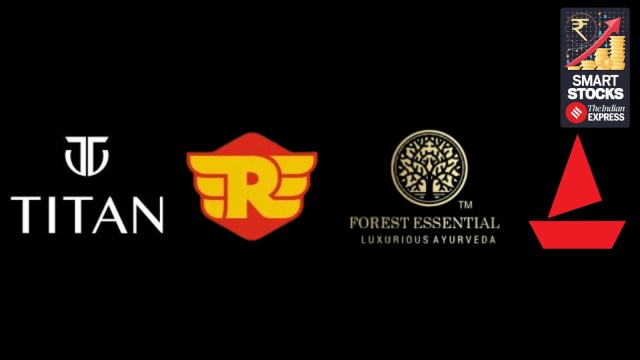India’s global brand moment? Titan, Royal Enfield, boAt are betting big on the world stage
After decades of staying local, Indian consumer companies are showing global ambition. What’s changed in capital, consumers, and confidence to make that possible now?
 In 2014, India ranked 54th on the World Bank’s Logistics Performance Index. Manufacturers struggled with product stability, label compliance, and import regulations in different climates. (Photos: Facebook/ Titan/ Royal Enfield/ Forest Essentials/ boAt)
In 2014, India ranked 54th on the World Bank’s Logistics Performance Index. Manufacturers struggled with product stability, label compliance, and import regulations in different climates. (Photos: Facebook/ Titan/ Royal Enfield/ Forest Essentials/ boAt)A decade ago, spotting an Indian consumer brand overseas was a novelty. You might find a Haldiram’s packet tucked into an ethnic store in New Jersey, or a Titan watch gifted by an NRI relative. But outside of the diaspora, Indian brands rarely showed up in the global mainstream, not in airports, not on digital shelves, and certainly not in lifestyle conversations.
That’s quietly beginning to change.
Today, you can walk into a Lenskart store in Singapore, see a Royal Enfield cruising down the streets of London, or order Mamaearth products from Amazon UAE. Zomato is back in the Middle East, House of Masaba is shipping to New York, and boAt headphones are showing up on international marketplaces not as curiosities, but as competitive choices.
It’s not a tidal wave, but it is a meaningful shift. And it raises a fundamental question: Can India finally build global consumer brands?
This article explores what’s different now, why a new class of Indian brands, from Titan and Zomato to Suta and Minimalist, believes it can go global, and what it will take to convert that belief into an enduring presence on the world stage.
Why Indian brands stayed local for so long
The current wave of global ambition among Indian brands marks a sharp break from decades of caution.

For most of independent India’s history, going global was rarely on the roadmap. Even successful consumer-facing companies opted to deepen domestic moats rather than seek international recognition. There were structural reasons for this restraint, and they weren’t trivial.
A big enough playground at home
India’s massive and underpenetrated domestic market gave little reason to look outward. Consumer brands had ample room to grow across languages, states, and income brackets, each as complex as entering a new country. Companies like Dabur, Marico, and Emami built empires by expanding regionally, not internationally.
Consider this: in 2010, over 85% of revenue for listed Indian FMCG firms still came from India. Even now, companies like Asian Paints have near-total dependence on the domestic market, simply because India has been large and profitable enough.
For promoters, the cost-benefit math was obvious: why invest in international markets with unknown dynamics when the next 200 million consumers were just moving from rural to urban?
Weak infrastructure and global compliance gaps
Even when demand existed abroad, largely among the diaspora, the supply-side readiness wasn’t there. Packaging didn’t meet international shelf standards. Cold chains and fulfillment were unreliable. Logistics costs were high, and Indian ports had a long turnaround time compared to Southeast Asian peers.
In 2014, India ranked 54th on the World Bank’s Logistics Performance Index. Manufacturers struggled with product stability, label compliance, and import regulations in different climates. Global retail demanded predictability, but Indian exporters, even with great products, couldn’t always deliver it.
For brands, this meant reputational risk. And for many, it simply wasn’t worth the stretch.
Promoters focused on execution, not identity
A deeper, cultural factor was mindset.
Indian business families, operating in low-trust, capital-scarce environments, were trained to optimise for survival. Their strengths were in cost control, supply chain, and distribution, not brand storytelling or cultural export.
In contrast to Japan or South Korea, where national pride backed brand-building (Sony, LG, Hyundai), Indian businesses remained execution-led. There was little precedent or pressure to go global.
Even when companies tried, they often entered through commoditised B2B exports (textiles, chemicals, pharma APIs) rather than brand-led consumer goods.
Public markets penalised brand-led bets
Until recently, even well-managed listed companies were punished for brand-building expenses. International forays were viewed as distractions. Marketing was treated as an overhead. There was no tolerance for negative cash flows in pursuit of global expansion.
In 2010, advertising-to-sales ratios for India’s top 10 FMCG companies averaged just 6-8%, among the lowest in Asia. By comparison, Chinese or Korean peers spent double building recall abroad.
Capital markets expected consistency, not risk. In that world, expansion meant more distribution, not more imagination.
India wasn’t seen as a country of brands
Finally, there was the perception problem.
Globally, ‘Made in India’ was known for cost and scale, not culture or aspiration. While China built brand infrastructure with state support, and Korea exported entertainment with consumer goods (K-pop + K-beauty), India exported software and services, largely invisible products.
Indian brands weren’t taken seriously because they weren’t framed to be. Even domestic success stories like Amul, Fabindia, or Titan didn’t travel, not because they couldn’t, but because they never positioned themselves to try.
For decades, these five headwinds made global ambition seem impractical. But in the past 5-7 years, each force has either weakened or reversed. Today’s Indian brand builder doesn’t face the same constraints. And some are already proving that the world might be more receptive than ever.
Where India’s global brand breakout might begin
Not every Indian brand is suited for global expansion. Categories rooted in hyperlocal taste, pricing sensitivity, or cultural specificity may remain inward-focused. But a handful of sectors where India has natural leverage, operational maturity, and export-ready appeal are already showing signs of traction abroad. These aren’t just early moves; they signal the start of a structural shift.
Mobility and engineering: Niche over mass
If there’s one brand that’s proven India can build a global recall, it’s Royal Enfield.
Once a colonial relic, the company has become an aspirational mid-segment motorcycle brand, not just in India.
In FY24, Eicher Motors exported close to 78,000 Royal Enfield motorcycles, accounting for nearly 12% of Eicher Motors’ two-wheeler volumes. Local assembly units in Thailand, Brazil, and the UK now support market-specific products.
Unlike mass-volume OEMs, Royal Enfield has succeeded by owning a niche: retro-styled, low-maintenance, torque-rich bikes ideal for leisure riders in Europe, South America, and Southeast Asia. This is a playbook that other Indian auto firms, particularly in electric two-wheelers or utility vehicles, are beginning to explore, though early stage.
Beauty and wellness: Tradition meets trust
The global clean beauty market crossed $20 billion in 2030, with consumers increasingly favouring products that combine natural ingredients with science and transparency. That’s where India’s Ayurveda heritage meets new-age formulation.
Brands like Mamaearth and Minimalist have begun international expansion, leveraging high-margin products (60%+ gross margins), direct-to-consumer distribution, and diaspora familiarity. Minimalist now sells on iHerb and Amazon US, with a product range that blends clinical actives with minimalist packaging.
Forest Essentials and Kama Ayurveda, while premium and slower-scaling, are building inroads in spa chains, boutiques, and hotels across Europe and the Middle East. What connects these brands is not just cost but cultural equity plus credibility.
Eyewear and fashion: Owning the new middle
Lenskart, with its recent acquisition of Owndays, now has access to 13 Asian markets and a physical presence in the UAE and Singapore. The company aims to become one of the top three global eyewear brands by volume in the next five years.
Unlike luxury brands, Lenskart competes on tech-led experience, affordability, and speed, backed by in-house design and manufacturing. Its supply chain allows for global delivery within 2-4 days, and its AR/AI tools standardise optical care across borders.
In fashion, brands like Suta, House of Masaba, and The Souled Store have become favourites among diaspora millennials and design-forward consumers abroad. Through Shopify storefronts and Instagram, they’ve found an audience that wants a slice of India — but on their own terms. Many report that 10-20% of their revenue now comes from international orders despite limited physical presence.
Packaged food and alcohol: Slow but emerging
India’s food has always travelled, but its brands did not until recently. That’s changing.
Sula Vineyards, listed in India and present in over 30 countries, has become a poster child for premium Indian wine. It meets EU regulatory standards and has seen uptake in parts of Western Europe, Japan, and the US. While international revenue remains in single digits, the strategic direction is clear.
Vadilal, known for its frozen desserts, now exports to over 45 countries. Products are modified for shelf stability and labelled to meet North American norms. Meanwhile, Haldiram’s is aggressively expanding in frozen foods, and its SKUs now show up in mainstream US grocery chains.
F&B still faces high barriers from regulation to taste adaptation, but brands that invest in compliance, distribution, and diaspora awareness are slowly carving out room.
Consumer electronics: The surprise contender
Perhaps the most unlikely success story is boAt. What started as a budget headphone brand has become the world’s fifth-largest wearables company by shipment volume, as per Counterpoint Research (Q4FY23).
While most revenue is still domestic, boAt now sells in the UAE, Nepal, and a few Southeast Asian markets. Its ability to integrate design, contract manufacturing (via Dixon, Kaynes), and low-friction distribution makes it a compelling player in emerging markets with aspirational but price-sensitive consumers.
The real unlock will come if boAt can combine audio, smartwatches, and wellness into a cohesive lifestyle offering abroad, moving from being “India’s budget brand” to a functional, stylish alternative to Chinese and Korean incumbents.
These sectors – mobility, wellness, fashion, food, and electronics – are India’s beachheads. Not because they’re trendy, but because they combine three key ingredients:
- A product that resonates globally,
- A cost structure that holds abroad, and
- A story consumers can connect to.
What happens next depends not just on the brands themselves but also on how well they execute over the years, not quarters.
The road ahead: What will separate winners from hype?
India’s global brand ambitions are real, but ambition alone won’t sustain them. For every Royal Enfield or Lenskart that builds momentum abroad, there will be others that fizzle out after an initial burst of visibility. From an investor’s perspective, the challenge is not just spotting what’s going global but also what’s doing so with durability, margins, and method.
Categories with a structural advantage will pull ahead
The first separator is category economics.
Brands operating in sectors with inherent Indian leverage, such as low-cost manufacturing (boAt), ingredient credibility (Mamaearth), or distribution verticals (Lenskart), have a natural edge.
In contrast, categories with complex regulatory hurdles, high localisation needs, or cultural opacity will expand more slowly or face higher burn rates. For example, personal care has far better export economics (60-70% gross margins) than packaged foods (~30-35%), where shelf life, adaptation, and regulation create friction.
Smart investors will back categories where India’s cost advantage doesn’t dilute product perception, a fine balance that’s hard to manufacture after launch.
Margin headroom matters more than revenue growth
Building a brand abroad is not a one-quarter game, as it’s a capital-intensive, multi-year journey. That’s why gross margin profile matters more than top-line growth when evaluating global expansion.
Brands like Minimalist and Lenskart operate at 60%+ gross margins, which allows them to absorb overseas customer acquisition costs, returns, and warehousing. On the other hand, even a Rs 1,000 crore revenue company with 30% margins will struggle to scale global operations without constant fundraising or dilution.
Investors should ask: Does the business have the operating cushion to experiment, fail, and try again globally without risking core profitability?
Retention beats reach
A common trap for D2C brands is early global visibility without retention. A spike in orders from the diaspora or through influencers can create vanity metrics, but if repeat rates don’t hold, the bucket is leaky.
Across D2C benchmarks, sustainable brands typically show repeat rates of 30-35% within six months, and CAC-to-LTV ratios under 3:1. These metrics are even more important in cross-border commerce, where logistics and returns cost 2-3x more than domestic.
What matters isn’t how many people tried the brand in Dubai or Toronto, it’s how many reordered without a festival or discount.
Global identity must be built, not assumed
Indian brands historically led with product or price, while global brands lead with identity and aspiration. The transition from exporter to storyteller is hard but essential.
Royal Enfield didn’t win because it was Indian; it won because it understood what retro motorcycling meant in Argentina or Thailand. Forest Essentials sells Ayurveda in the UK not as tradition but as a premium ritual. boAt’s success abroad will hinge not on being cheap, but on offering tech with style that fits urban lifestyles.
Investors should look for companies that show early signs of localised messaging, international hiring, or product adaptation, not just export shipments.
Patience will be rewarded, not hype
Building a global consumer brand takes 10-15 years in most cases. Dyson, Uniqlo, and Shein all spent a decade scaling abroad before achieving profitability. Indian brands will need similar timeframes.
Even now, most of the companies mentioned here, such as Lenskart, Mamaearth, Royal Enfield, boAt, derive less than 20% of their revenue from international markets. That number will rise, but slowly. What matters is that the systems, including supply chain, storytelling, capital, and customer understanding, are now in place.
For investors, this means ignoring quarterly noise and focusing on long-term optionality. The next Shein may not emerge from India. But the next globally respected premium skincare line, smart wearable, or fashion-tech hybrid might.
Closing thought
India has long exported commodities, code, and capabilities. It may finally be ready to export brands, not just to its diaspora, but to discerning consumers in cities from Singapore to San Francisco.
The brands that succeed will be the ones that compound not just capital, but cultural credibility. And for investors with a long-enough lens, this could be one of the most underappreciated structural stories of the next decade.
Note: This article relies on data from the annual report and industry reports. We have used our assumptions for forecasting.
Parth Parikh currently heads the growth and content vertical at Finsire. He holds an FRM Charter along with an MBA in Finance from Narsee Monjee Institute of Management Studies.
Disclosure: The writer and his dependents do not hold the stocks discussed in this article.
The website managers, its employee(s), and contributors/writers/authors of articles have or may have an outstanding buy or sell position or holding in the securities, options on securities or other related investments of issuers and/or companies discussed therein. The content of the articles and the interpretation of data are solely the personal views of the contributors/ writers/authors. Investors must make their own investment decisions based on their specific objectives, resources and only after consulting such independent advisors as may be necessary.
Must Read
Buzzing Now



Jun 05: Latest News
- 01
- 02
- 03
- 04
- 05






















